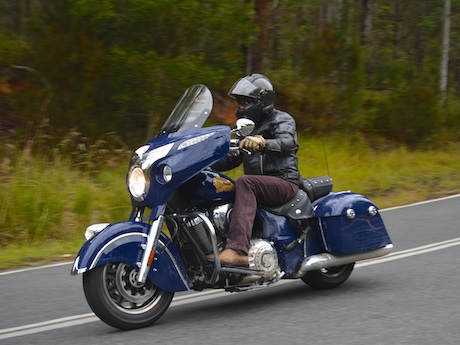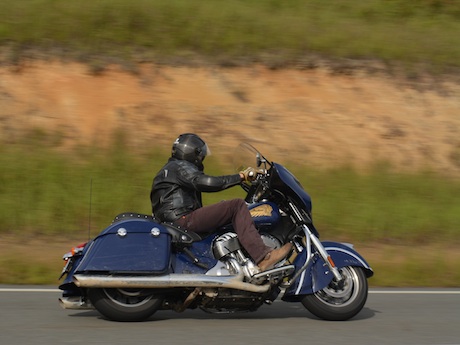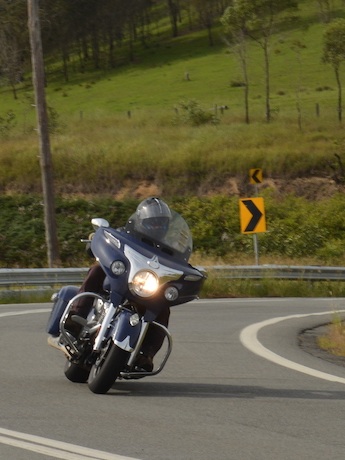A 1500km road test over three days on some treacherously bumpy and slippery roads in steaming heat and cold rain has confirmed that the Indian Chieftain is a competent long hauler. It’s comfortable, powerful, refined, a real head-turner and, at $35,995 ride away, it’s also great value for money, coming standard with cruise control, internal handlebar wiring, steel braided lines, ABS and keyless start like all the Chief range. The Chieftain adds a fork-mounted half fairing, audio system, lockable hard panniers and electric windscreen.
STYLING
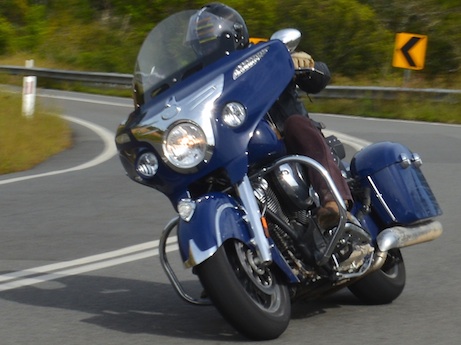
With its deep valanced fenders and removable tasseled upholstery, there is no doubting this is an indian in the finest traditions of the 112-year-old brand. Even the engine has that old side-valve look and “knucklehead” rocker covers. Everywhere I took the Chieftain, it provoked second looks from passersby who may or not may not even know what it is. Drivers pulled alongside for long gazes on the highway and other riders gave it the thumbs-up. Build quality is superb with minimal and matching panel gaps, quality controls and a feel of genuine craftsmanship.
TECHNOLOGY
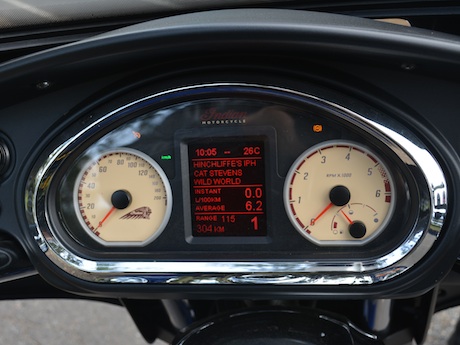
Next to it is the switch for the windscreen which adjusts the height by 10cm in five seconds. Even at its lowest there wasn’t a lot of buffeting and I could just see over the top in its lowest position. At its top, there was no buffeting and little wind noise. However, it does reflect the chrome on the fuel tank right in the centre of your field of vision. It was distracting at first, but after a while I ignored it.
The entertainment system includes radio, Bluetooth and a USB connection in a secure and waterproof housing on the right fairing. It will also power your player or iPhone and there is an extra 12V plug on the left of the instrument panel for a GPS or CB. I used the Bluetooth and played music through the speakers when it was dry and I could have my visor up. When it rained and I put my visor down I chose the headset option and listened to music in my helmet. I like the convenience of the bike’s speakers, but the sound quality is not great.
The cruise is easy to operate and it works well, even though it’s on the right switchblock rather than the left. The Chieftain comes with a keyless fob that you can keep in your pocket. To start the bike, hold the ignition switch for a couple of seconds, hit it twice, or hit the switch on the centre of the fuel tank which turns on the electrics, then hit the ignition. Below the “on” switch on the fuel tank is a pannier lock/unlock switch to quickly secure your luggage.
ENGINE
The heart of the Indian Chieftain is the powerful and refined 111cc Thunder Stroke engine. Start it up and there is no initial thump or mechanical noise, just a gentle rumble at idle. Blip the throttle, which feels a little elastic, and it revs quickly and freely. This translates into rapid acceleration in lower gears. It really comes alive, though, at 4000 revs without feeling rough or raucous. However, you don’t have to use the gears to keep it in a sweet rev range for overtaking, just roll on the throttle in just about any gear. At 100km/h in six it is purring at 2250rpm from where you can accelerate sweetly without having to drop a gear or two as it is geared lower than its American cousins.
While the engine is quiet, the fairing and screen echo a little bit of engine rumble, valve rattle and transmission whine back at you. The exhaust noise is almost non-existent until you hit high revs and then it sounds very macho. You can get aftermarket tailfin pipes which have a very macho note.
On my 1500km test, it achieved 5.7L/100km fuel economy which is pretty good for a bike weighing almost 400kg and being ridden hard at times on country back roads. On the highway, it sipped fuel at just 5.2L/100km and on a hard run it never went much past a low 6L/100km.
TRANSMISSION
The gears are positive but not too clunky. I found that you could totally get rid of any clunk on changes if you preload the gears by putting some pressure on the lever before you engage the clutch. There is a gear indicator on the instruments but you will usually just whip up through the gears using the huge amounts of torque. It comes with belt drive which doesn’t have any snatch or noise.
HANDLING
Ride is pleasant and composed. No crashing through the bumps, wallowing through the bends or steering vaguely into corners.
With a sharper steering angle on the Indian Chieftain it is a more precise steerer than the other Chief models, although it’s not as accurate as the Harley Touring models. Clearance is surprisingly high, but you will scrape the floorboards, some exhaust pipe and some chassis when you get aggressive.
Some potholes caused a bit of bump steer from the 46mm forks which are a bit slimmer than on the Harley Touring models. The flexible bars also bounce and vibrate over harsh bumps. However, there is none of the high-speed weaving or side-to-side buffeting you get from some half-faired bikes with fork-mounted fairings. The wide beach bars also give you a good grip on the bike and help to keep things stable at high speed. If you don’t like the wide bars, you can get accessory bars that also come with the same discrete internal wiring as the standard bars. Those big bars also make tight, feet-up turns easy, if a little physical.
The Dunlop American Elite tyres are hard and probably hard-wearing, but they lack some grip in the wet where they tend to spin up a bit and slip under braking.
BRAKES
The front disc brakes are strong, but you have to give the lever a fair squeeze. Thankfully the steel braided lines give you plenty of lever feel. While the front brakes are effective, the rear brakes tend to lock up bit quickly at high speed and at low speed. Also, the ABS sounds very abrupt and clunky, although it does work, especially in the wet.
Because of legal issues, you can’t trail brake the rear through a corner and accelerate at the same time as the engine cuts out. This is due to an issue in the USA where Toyota Camry floor mats would wedge between the brake and accelerator and when you hit the brake, it would also hit the throttle. So the USA has now mandated that the throttle on all vehicles has to shut down when the brakes are on.
COMFORT
At one stage, I rode from a full tank to the “low fuel” light – about 300km – without stopping and didn’t feel any discomfort at all. The genuine leather seats on the Indian Chieftain are plush and comfortable, although the brown leather on the Vintage is a little softer. The low 660mm rider’s seat narrows at the front making this suitable for people of most heights.
On the press launch last year I felt the cockpit might be a bit cramped for tall people, but I was wrong. Reach to the floorboards is generous and there is plenty of room to move your feet around. Even at 187cm tall, I could put my legs out straight with my feet propped against the chromed engine protection bars. Pillions will also find the foot pegs are a generous length from the wide and plush perch.
Reach to the bars is just right for me and my injured upper back. Cruise control allowed me the luxury of being able to relax my right hand, although the wide grips don’t cause cramp.
In hot weather, the rear valve cover gives off a lot of heat in your crotch and on the backs of your thighs. It’s uncomfortable in traffic, but on the highways it blows away. In the cold and wet it just provides that little bit of extra comfort.
VERDICT
On long days in the saddle you will appreciate the comfort and performance of this long hauler. Ride the Indian Chieftain all day and into the night with a wide spread of bright light – you’ll never want to stop.
SEE MY PAGE OF PHOTOS ON PINTEREST
Indian Chieftain tech specs
- Price: $35,995
- Warranty: 2 yrs, unlimited km, roadside assistance
- Service: 800/8000k, or 12months
- Engine: air-cooled 1811cc Thunderstroke 4-valve V-twin
- Bore x stroke: 101 x 113mm
- Compression: 9.5:1
- Power: not stated
- Torque: 139Nm
- Transmission: 6-speed, wet multi-plate clutch, belt drive
- Suspension: 46mm telescopic forks, 119mm travel; single rear shock, 94mm travel
- Brakes: 300mm floating discs (twin front, single rear), ABS
- Tyres: 130/90B16; 180/65B16
- Wheels: 40-spoke 16×3.5, 16×5
- Seat: 660mm
- Wheelbase: 1668mm
- Length: 2570mm
- Wet weight: 385kg
- Fuel: 20.8L tank, ULP
- Fuel economy: 5.7L/100km (tested)


